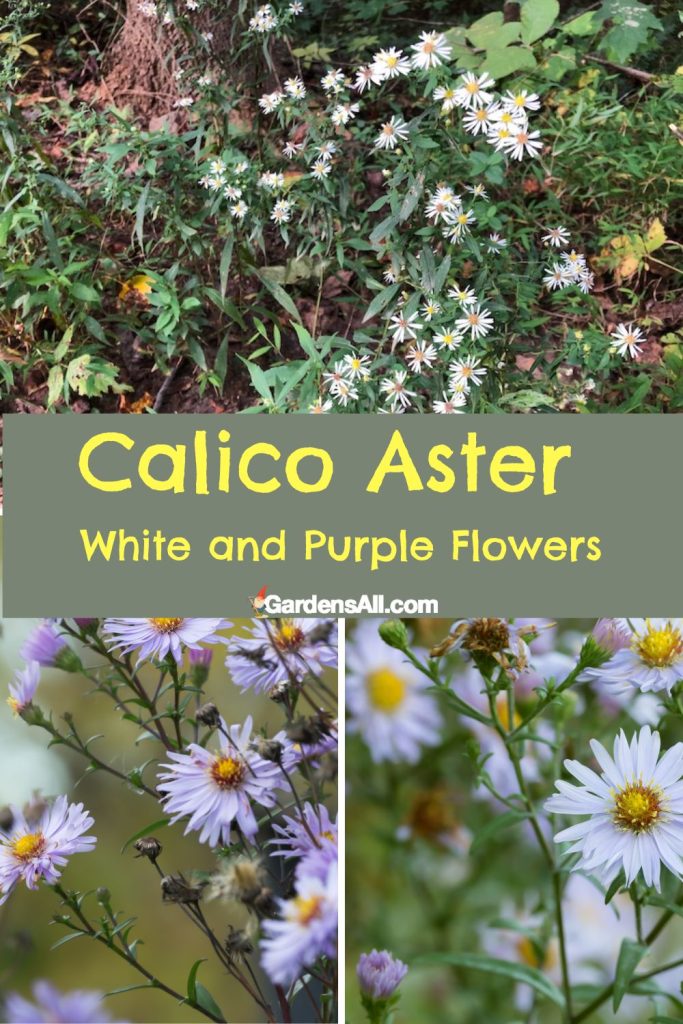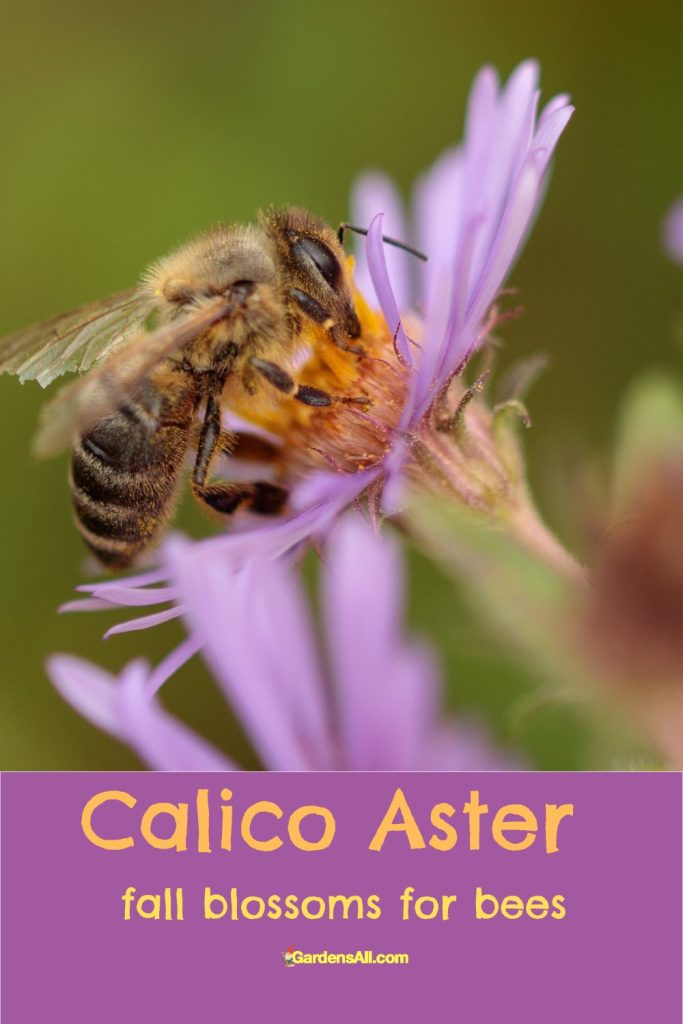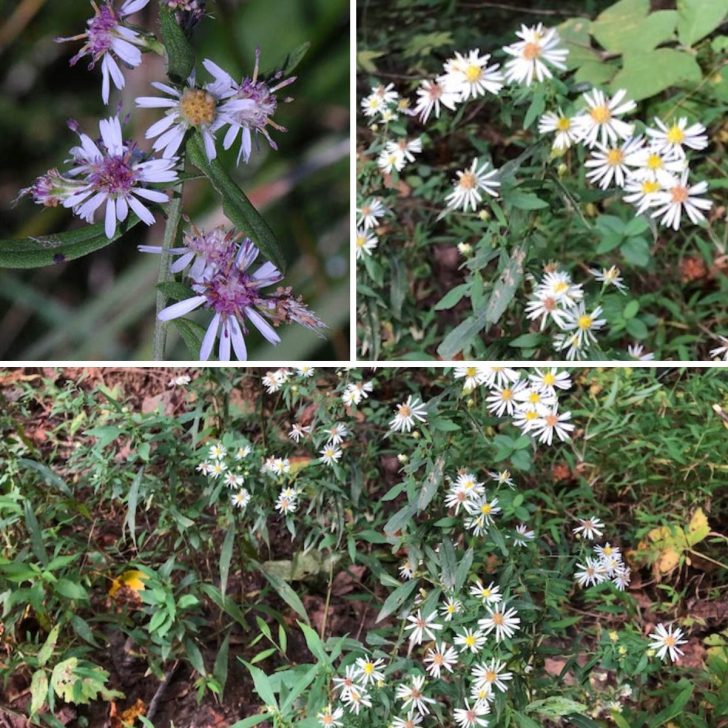See Symphyotrichum lateriflorum Growth, Uses and Benefits
Out on our usual daily walk with the dogs, we encountered fresh fall sprigs of a white wildflower. Hmm… fall-blooming, daisy-like wildflower… turns out it was a calico aster.
At a glance, it could be mistaken for daisy fleabane, another member of the asteraceae family. However, the calico aster is an herbaceous perennial found blooming in fall from August-October, depending on the region you’re in. Whereas daisy fleabane blooms in spring and early summer.
We could stop at the benefits of asters as a perky white fall flower, but this unpretentiously bold weed has more to offer. Often found on the side of the road, in woods or meadow, this fall blooming flower provides nectar for local bees and other pollinators, plus beneficial insects, and ethnobotanical benefits.

Calico Aster Names
Scientific Names of Calico Aster
- Symphyotrichum lateriflorum
Symphyotrichum Lateriflorum Genus Name Meaning
The calico aster’s botanical name comes from the Greek:
- symph – meaning coming together
- trich – meaning hair after the hairy calico anthers (the part of a stamen that contains the pollen)
- lateriflorus – laterally growing with flowers branching out horizontally (laterally) and relatively low to the ground. Although some stems grow up to around two feet.
Common Names of Symphyotrichum Lateriflorum
The most common of the common names for Symphyotrichum lateriflorum is Calico Aster. The calico nickname is from the tendency of the flower heads to change color as the flowers grow and age.
From a bright yellow center and morphing to orange, red-orange and then to purple, the centers of this calico aster change color and often have more than one color on the same plant.
- Aster wildflower
- Calico aster
- Fall aster flower
- Panicled aster
- Prince aster
- Side-flowering aster – (referring to flowers growing on only one side of the stem)
- Starved aster
- White woodland aster

Weeds With White and Purple Wildflowers
If you’re looking to identify weeds with white flowers with yellow centers, white flowers with orange centers or white flowers with purple centers, it may be a calico aster.
Many of the aster wildflowers can be hard to distinguish completely, one from the other, because of cross pollination resulting in interbreeding amongst them. However, most have similar traits, benefits and uses.
So when you see small white wildflowers in fall, with yellow, orange or purple centers, and rays of petals that can also be purple or tinged with pink these may just be calico asters.
These delightful fall blooming white wildflowers are often sporting the fall colors of yellow, orange and dusky purple and may even include different colors on the same plant.
DISCLAIMER: This is a guideline only toward helping you identify the calico aster and should not be used prescriptively or consumed in any way without relevant professional guidance towards identification and usage.

Calico Aster Description
- FLOWERS – growing on one side of straggly, divergent branches:
- Small ray petals emanating from a colorful center head round ray with petals colors that can be:
- white
- pale pink
- muted purple
- Flower heads (centers) can be:
- white
- orange
- reddish-orange
- dusky purple ray
- Small ray petals emanating from a colorful center head round ray with petals colors that can be:
- LEAVES –
- are a medium green and a small narrow lanceolate shape:
- narrow
- pointed
- are a medium green and a small narrow lanceolate shape:

How and Where Does Calico Aster Grow?
The calico aster can often be seen trailside when hiking woodland paths and narrow dirt or gravel lanes, thus the common name of ‘white woodland aster. These woodland settings tend to provide the perfect filtered sunlight with sparse amounts of full sun, plus humus rich soil with good moisture.
Finding or Growing Calico Aster
- BLOOMS – white or purple flowers in fall, August – October, depending on which zone it’s growing in
- HABITAT – fields, thickets, trailside, and woodlands
- REGION – native to North America and can be found in most states and Eastern half of the US, and Canada, from Ontario to Nova Scotia
- SIZE – averages 2.5′ tall x 2.5′ wide when flowering
- SOIL – moist, well-drained
- SUN – full sun to partial shade
- WATER – medium
- ZONES – 4-8

Medicinal Uses and Benefits of Asters
Scientific Research on the Medicinal Uses and Benefits of the Asteraceae Family of Plants
The members of the Asteraceae have been used in the diet and for medicine for centuries.[1]https://www.ncbi.nlm.nih.gov/pmc/articles/PMC7999649/#:~:text=The%20Asteraceae%20family%20is%20one,and%20for%20medicine%20for%20centuries.
SOURCE: Study on The Plants of the Asteraceae Family as Agents in the Protection of Human Health
Ethnobotanical Uses of Calico Aster
Ethnobotany is the name for traditional regional and cultural uses of plants. Some indigenous tribes such as the Ojibwa and Iroquois, used calico aster for food and medicinal uses.
The flowers are also edible and Chinese herbalists brew wild aster root tea for various ailments.[2]https://1stchineseherbs.com/a/aster-root/
Medicinal Uses of Aster Root Tea
- dissolve phlegm
- fever
- ease cough
- immune system support
- inflammation
- moisten lungs
- respiratory function
Uses for Wild Aster Root and Flowers
Calico Aster Uses
In Landscapes
Calico aster can be a border plant as a sidewalk border or low hedge in your yard.
Beyond the benefits to pollinators and beneficial insects, the flowers and leaves can be consumed fresh or dry in foods or as tea.
Flower Uses of Calico Aster Dried or Fresh
- Tea, dried or fresh
- Salads, fresh blossoms perk up salads
Leaves Uses of Calico Aster
- Leaves –
- cooked in:
- soups
- steamed
- sauteed greens
- fresh in:
- salads
- green juice or smoothies
- cooked in:
Roots Uses of Calico Aster
- Added to soups
- Dried for tea


Environmental Benefits of Calico Aster
Loved by Pollinators
Bees and butterflies need the nutrients that fall blossoms such as calico asters provide.
The fluffy flower center head prominently beckons bees, who need calico aster as one of the important fall wildflowers favored by bees.

REFERENCES:

I’m LeAura Alderson, a garden, herb and plant enthusiast with a passion for discovering the many edible and medicinal benefits of the plants all around us, including the weeds! I’m a writer, editor and media publisher for our family of websites.
While I was certified in fitness and life coaching, I am NOT a health practitioner. However, I’m a lifelong health enthusiast, with a keen interest in healthy, organic foods and making home remedies and the content we share is from our own experience and usage as well as that extracted from scientific research so that you can explore further on your own.
Always seek the advice and guidance of your health practitioners first and foremost.
As a family we’re steadily expanding our gardening, experimentation and knowledge around all things gardening, edible landscaping, fresh organic foods and self sustainability with farming in our future. I also own and manage iCreateDaily.com, a site all about transformation through creation, and the power of positivity, optimism and mindset.
References

